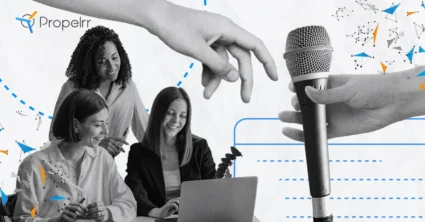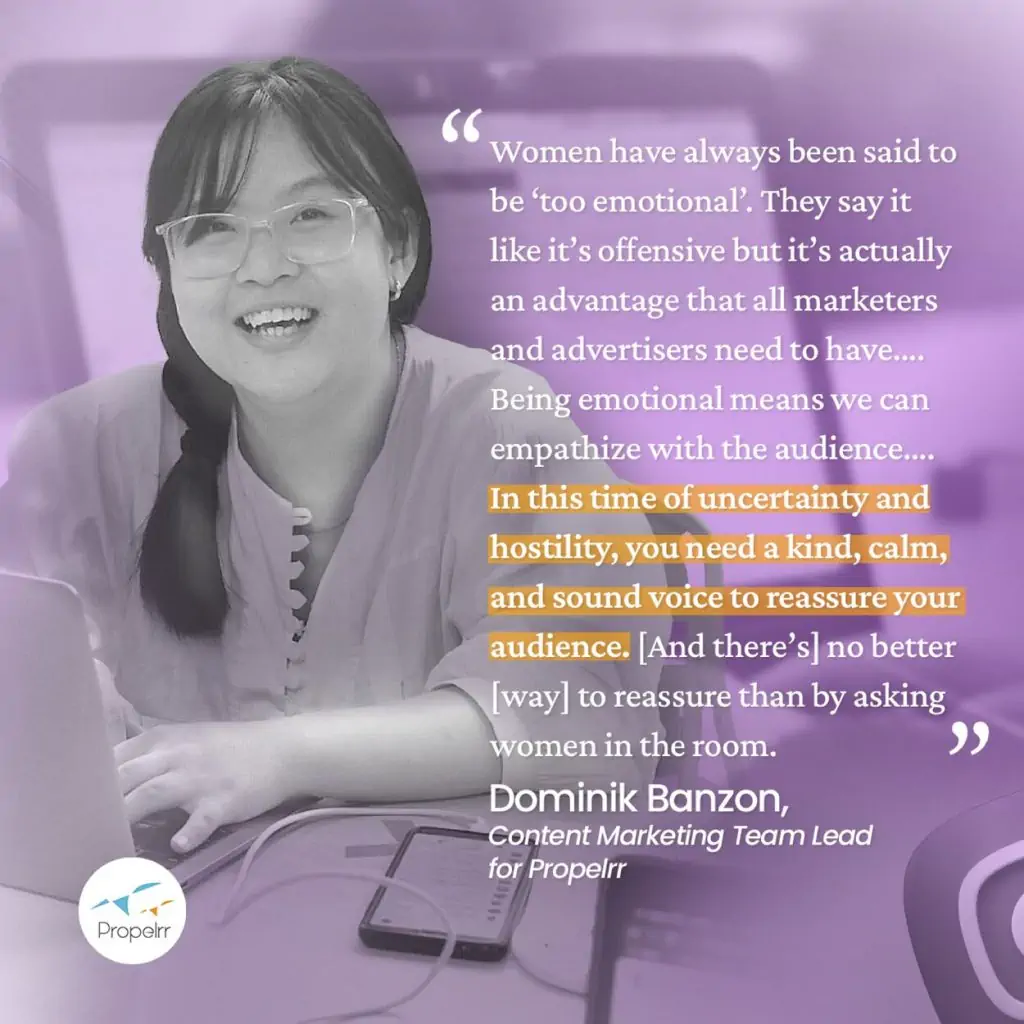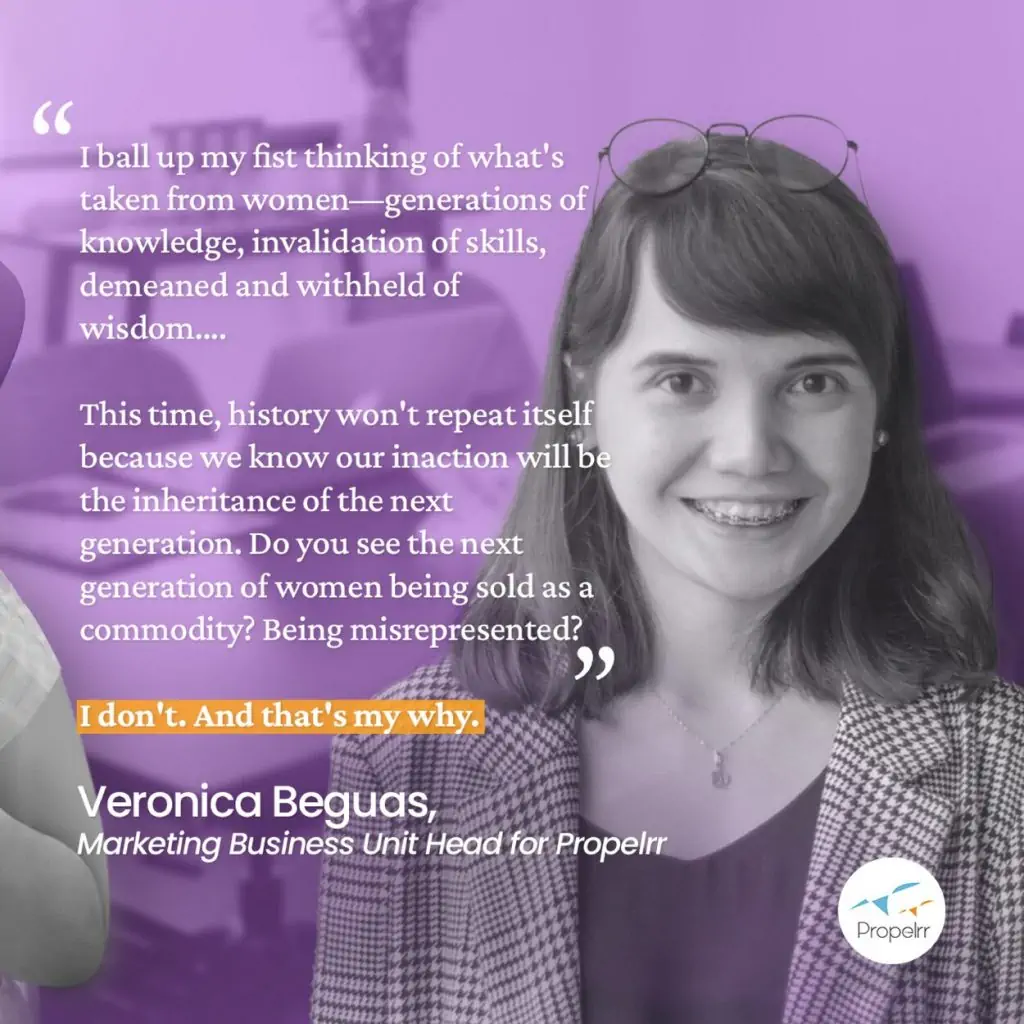Want Better Ad Ideas? Pass the Mic to the Women in the Room
Author & Editor
Content Team Lead
Published on: Mar 8, 2022 Updated on: Oct 3, 2025

Table of Contents
These days, “better ad ideas” don’t just require flashy images and witty texts to be effective. In a world that’s growing more and more tired of insensitive messages, it now also demands empathy. And in specifically marketing to women, you can win more business if the mic is passed onto the women in the brainstorming room.
We’d like to believe that, in the world of digital marketing and advertising, misogyny doesn’t exist anymore. But when a beauty commercial on social media hints that “you’ve let yourself go,” and hence, are no longer desirable, then you can’t really help but argue otherwise.
And it’s frustrating to think that this isn’t or won’t be the last example of sexist advertising we’ll see in our time. Not until a radical and necessary change comes about and is maintained inside the brainstorming bubbles of creative advertising agencies.
Because women are tired (to say the least) and they refuse to pay attention to your ads if you’re not challenging the way you “creatively” represent women. But no matter how the road towards better representation of women in ads and ad agencies differs, it all starts with policing misogyny, even in its subtlest manifestations.
Policing sexism and misogyny in advertising
For many women, advertising is still the ‘Mad Men’s” world. But at this point in time, pinning the problem solely on gender representation in the workplace would risk downplaying the gravity of the issue. Because, as with all issues, it’s never just about a problem with representation.
While trying to learn about the many ways sexism and misogyny reveals itself in ads, I stumbled upon the term ‘sneaky sexism’. A coined phrase mentioned in a Forbes article tackling the possible reasons why businesses and ad agencies alike can’t seem to eradicate this toxic way of thinking from their organizations.
In the piece, Michelle King cites global brand marketing expert Tim Parkin, who shares that, put simply, sexism prevails because:
- being judgmental works;
- denial is convenient, and;
- women’s representation in management is enough.
When obviously, it isn’t. Because if it really were enough, women around the world would be spared having to roll their eyes at ads that have yet another opinion about how they should act, dress, or look. If allowed to continue, this could imperil how society and women themselves perceive their value and roles in society.
On a girl’s 17th birthday, she’d have lived long enough to see 250,000 ads. The majority of which reinforce negative gender stereotypes, according to Parkin. That should put into context how much work there’s still left to be done in terms of switching the narrative to protect women today, and the next generation.
So, how do we fix it? Unsurprisingly, it’s quite simple. In the same article, Parkin suggests the following countermeasures to overcome the ‘hurdles’ stated above:
- Shift from being judgmental to aspirational. Be an inspirational force, rather than one that relies on derogatory narratives to sell your products.
- Develop a sense for detecting and policing misogyny. Conduct a study into ads with problematic messaging and develop a keen sense for how misogyny presents itself, and accordingly, police them.
- Move beyond representation, and listen. Don’t be the organization that puts women in positions of power in organizations, yet talk over and ignore their feedback and opinions. Listen, and do so actively.
Now, let the women tell you why
It’s interesting to think that, while 70 to 80% of consumer purchasing decisions are driven by women, efforts to market to them are falling short of expectations for more inclusive messaging.
With the tons of anecdotal evidence of ads employing sexist tones in messaging, it’s about time to ask ourselves some harder questions. Like:
How much do we really value the importance of proper representation of women in the advertising world? And what do businesses and agencies have to gain beyond profit just from listening more actively to women when it comes to strategy and execution?
Going around the virtual rooms for Propelrr, I went ahead and asked the inspiring women of the team to give some of the best answers to this question.
Innovation in product and other design aspects.
Given how counter-equality arguments rest on the biological differences between men and women, you’d think designing for women would be instinctive and rampant. Because, after all, women are built differently and our experiences of the world are unique from men – for better or worse.
 Photo by Propelrr[/caption]
Photo by Propelrr[/caption]Ironically though, it’s not. And from running shoes all the way to infrastructure, the world still has ways to go in designing and innovating for women. Propelrr’s User Experience Design Specialist Raffy Punzal cites a case where, in the US Capitol, female lawmakers were using women’s restrooms for tourists until 2010 when she said;
“Women’s voices should be louder in general as women – and really, any marginalized group – can offer a new perspective on things not previously considered by their male counterparts…. With men’s experiences at the helm, sometimes women become an afterthought [to design].”
We can’t change the past if we don’t amplify female voices.
You can’t expect a long history of silencing women to change if, until now, you are still gatekeeping ideas and strategies from women. This was pronounced similarly by Nica Baquilod, one of our social media marketing specialists here in Propelrr.
 Photo by Propelrr[/caption]
Photo by Propelrr[/caption]According to her, passing the microphone to women in advertising is important “for marketing and advertising agencies to...reform antiquated ideologies used to silence women and to give birth to new ideas that would empower us.”
After all, there is no easier way to empower women than giving them a platform to speak and feel heard. Because at the heart of all movements for change is this willingness to listen and, subsequently, take actions to create inclusive workplaces, in all sense of the term.
Being emotional is a business advantage.
If you run a search on the business value of empathy and emotional marketing, the literature you'll find is enough to sway you to dial up the emotional intelligence. As it turns out, emotions benefit business. And while women have long been looked down on for our "sensitivity," they now work to give us the upper-hand in terms of coming up with better ad ideas and business strategies.
 Photo by Propelrr[/caption]
Photo by Propelrr[/caption]Propelrr's Content Marketing Team Lead, Dominik Banzon has a moving statement on this:
"Women have always been said to be ’too emotional’. They say it like it’s offensive but it’s actually an advantage that all marketers and advertisers need to have, regardless of gender. Being emotional means we can empathize with the audience; being emotional means we can read the room and avoid further mishaps, if any; and being emotional means connecting with the audience thoughts and feelings and know exactly what needs to be said."
An apt sentiment given that today's social climate demands more authenticity in terms of how we perceive, act, and interact with others. This is true, and demanded even of brands now, more than ever before. And, as Parkin puts it: "Ignorance is not a pass anymore," because women want and deserve more.
"We’ve all had a fair share of hurt or pain from derogatory statements or offensive side comments that we don’t want to pass on the negativity to other people, especially other women. In this time of uncertainty and hostility, you need a kind, calm, and sound voice to reassure your audience. No better to reassure than by asking women in the room what they feel and think of, you’d be surprised how easy it is to gain empathy and build connection all along."
READ ALSO: 5 Ways to Inject Emotional Resonance in Your Online Content
It keeps us from repeating the treacherous mistakes of the past.
Lastly, amplifying female voices in advertising agencies is critical to the continuity of our achievements in this effort to safeguard our creative ideas from sexist ideologies.
"Because women won't march back to what was. We never should," declares Propelrr's Business Unit Head for Marketing, Veronica Beguas.
 Photo by Propelrr[/caption]
Photo by Propelrr[/caption]Referencing her years of experience both as an audience to and brain behind many advertising campaigns for brands, she expresses her frustration at how misogyny and sexism has prevailed in marketing. She describes how women have been historically and continually portrayed in advertisements:
"Looking back generations ago, I ball up my fist thinking of what's taken from women – generations of knowledge, invalidation of skills, demeaned and withheld of wisdom to share. In advertising, women were portrayed as attractive yet utterly brainless only to highlight a man's skills and appeal."
And that, while she's glad that things have evidently changed in some ways, it's "not enough to make up for the man-made and unjustified representation of women in advertising." She further expands to tackle the matter of the breadth and diversity that's lacking in women's representation, asserting that "there is still work to be done," as "more kinds of women continue to be largely ignored, and misrepresented; whose lives largely go unseen."
She emphasizes the importance of shining the light on "women who lead a team or a nation, who fight, who run businesses, who ideate, who know how to code." All colors and types of women who who wear pants, actively choose not to have kids who can and should equally coexist with women who are typically described as "dainty" or "fair"; the women wear dresses, love flowers and poems, enjoy makeup and jewelry, love to cook, and spend most of their time at home.
Never pitting one against the other but rather, telling young girls and all women that they can be anything they choose to be without worry of being confined to a label or stereotype:
"Instead of portraying a world where others have to refuse to be "feminine" to be considered strong, as advertisers and marketers, we owe the next generation a world where women have the choice to be anywhere they want on the spectrum, to do anything they want."
She throws us back a question to ponder on – poignant enquiries that should urge us to continue seek better solutions for representing women in adverting better:
"How often have we failed to use the best of our creativity to represent women because our perspective was two-dimensional? How many opportunities have we missed to connect and leave an impact because we lacked the insight to see women as complex beings with multiple layers of needs and competence?"
Her final assertion is one that sees a hopeful advertising and marketing environment for future generations of women, and asserts that:
"We won't march back to what was, but women will move to what shall be. And as women in the advertising community, we will not be turned around. No, this time, history won't repeat itself because we know our inaction will be the inheritance of the next generation.
Do you see the next generation of women being sold as a commodity? Being misrepresented?
I don't. And that's my why."
Closing this off with some tips for the men
To cap this off properly, we want to give a final reminder that creating better ad ideas, environments where women can truly thrive, and be properly represented is a collective effort. Meaning, the men need to be in on it, too.
We owe it to the young girls who will grow into women, later on. Below are some ways women's empowerment organization Lean In suggests men can become better allies in pushing for equality in the workplace:
- Challenge the “Likeability Penalty."
- Evaluate men and women's performance, fairly.
- Give women credit.
- Avoid talking over women in meetings.
- Share office housework.
- Eliminate the negative bias against working mothers.
- Mentor women and offer equal access to opportunities.
How do you actively feature the voices of women in your organizations? Chime into the conversation via the comments, or shoot us a message via Facebook, X, or LinkedIn.
Let's talk about strategies via our newsletter! Subscribe now, and get instant access to weekly tips sent straight to your inbox.
